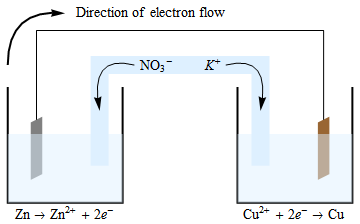I was learning about voltaic cells and came across salt bridges. If the purpose of the salt bridge is only to move electrons from an electrolyte solution to the other, then why can I not use a wire?
If you connect the two electrodes with a wire, you will short-circuit anything else connected to the electrodes. If you connect the two electrolyte solutions with a wire, there are two things that could happen:
- nothing (if there is no redox reaction happening at the wire/electrolyte interface, there will be no charge transfer. The wire can't transport ions, and the electrolyte can't transport electrons).
- two more half-reactions (if there are half-reaction that the respective combinations of electrolyte and wire material can support)
In either case, this will not have the desired effect of a salt bridge, which is to balance the charge buildup that occurs when electrons travel along the wire from anode to cathode.
Also, will using $\ce{NaCl}$ instead of $\ce{KNO3}$ in making the salt bridge have any effects on voltage/current output of the cell? why?
The voltage and the current depend on what load you attach to the voltaic cell, and properties of the cell itself.
If ion transport along the salt bridge is the rate-determining step, it will affect the current (current is movement of charge per time). If you measure the voltage under load, it will also be affect by the nature of the salt bridge.

